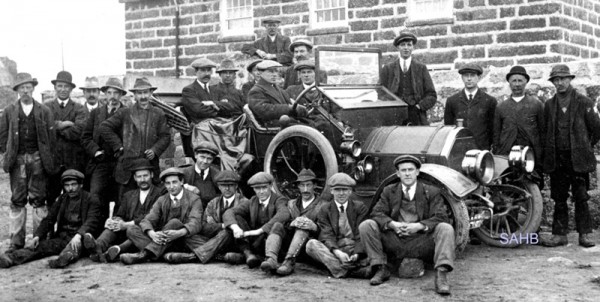
Although Mitchell automobiles hailed from Racine, Wisconsin, USA, this shot was taken far from their homeland – in ‘Olde England’, not the new one. Having said that, it is though about as close as it is possible to get in mainland Britain to America, given that the location is about 5 miles north of Land’s End, specifically at Botallack Tin Mine. This had been started in 1815 and it closed 80 years later, but intermittent activity continued there until 1914. The mine buildings were perched on the very edge of the cliff that descends into the waters of the Atlantic and eventually some of the workings extended westwards for a fair distance beneath the Ocean.
Why the photograph was taken is not known, nor precisely when, but as the car appears to be a 1910 model and it looks to be in good condition apart from the bent front mudguard, then it must have been around that date. We can assume that most of the workforce were present and perhaps it is the mine-owner who is at the wheel of the car, although why he should have chosen a Mitchell is also not known.
In its 1910 adverts Mitchell stated that it had been in the automobile business for 10 years and general engineering for 86 years, but certainly the first figure is a trifle exaggerated as Mitchell cars were not offered for sale until 1903. In 1906 the firm announced that all sales would take place direct from the factory, not via dealers, and this would enable prices to be kept down, but by 1910 there was a ‘European Branch’ in Paris and agencies in Britain.
For the 1910 season the appearance of the cars was changed and this included the adoption of a Mercédès-shaped radiator and straps for the bonnet, which makes identification of this example reasonably straightforward. Despite the nature of the firm’s advertising, which for a time was a full-page announcement in the British journals, production was never large with just over 5,600 cars made in 1910. After several changes of ownership and the company name, the business closed in 1923.






